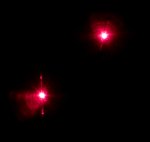Meatball
0
- Joined
- Feb 1, 2008
- Messages
- 2,894
- Points
- 0
Mike, do you have an accurate spectrometer? When the diode gets hot, It MAY be going through a wavelength shift. This would make the diode far less efficient as it is not lasing at its DESIGNED wavelength. Is this a possibility to consider? Even a shift of 3-4nm could make a big difference in the efficiency of the diode. Have you tried cooling the diode while it runs?




